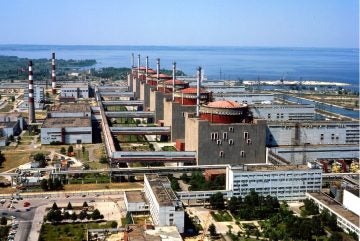
On 13 June, the International Atomic Energy Agency team at Zaporizhzhya NPP reported hearing explosions, including several close to the plant, on several days over the previous week. They confirmed with staff at the plant that one of the mines located close to the ZNPP cooling pond area exploded on 11 June. However there was no physical damage or casualties caused by the explosion and its cause was not shared with the IAEA team.
“This latest explosion, so close to the plant, is of grave concern and is aggravating an already fragile situation,” said IAEA director general Rafael Grossi, emphasising that “nuclear safety and security of the ZNPP cannot be compromised.”
On 10 June, IAEA team members visited one of the electrical sub-stations located in the nearby town of Enerhodar. Their purpose was to observe the impact of an alleged shelling which, according to the ZNPP, occurred on 8 June and resulted in a fire and damage to the substation which serves the Enerhodar city council building where the main communication hub between the ZNPP and Enerhodar is located. ZNPP confirmed that the damage did not interrupt the communication lines.
The evidence of frequent military activity near the ZNPP is a continuation of the shelling and drone bombing that has become a feature of life near Zaporizhzhya ever since it became clear that the Russian army was targeting Ukraine’s energy infrastructure. The upsurge in Russian strikes increasingly aimed at the country’s electricity system has put a heavy strain on Ukraine’s power grids, with several power plants being destroyed or disabled. Owing to the resulting power deficits, Ukraine began implementing rolling shutdowns on 15 May. The IAEA team of experts stationed at the ZNPP have continued to hear explosions at various distances from the plant during the last few weeks.
These events amplify concerns around attacks on the electrical power infrastructure elsewhere in Ukraine during the week of 13 May: in the week of 20 May, ZNPP informed the IAEA of a drone attack on a transport workshop in the nearby industrial area, reportedly causing some damage but no casualties. That strike, around four km from the ZNPP site, would further underline the continuing military-related risks facing this major nuclear facility, following April’s drone attacks targeting the site itself.
“For the outside world, the situation at the Zaporizhzhya NPP may have appeared relatively calm in recent weeks, since the drone attacks on the site in mid-April. But this is not the way we see the situation on the ground. The stark reality is one of constant danger. The nuclear safety and security situation at the site remains extremely vulnerable,” said IAEA director general Grossi.






